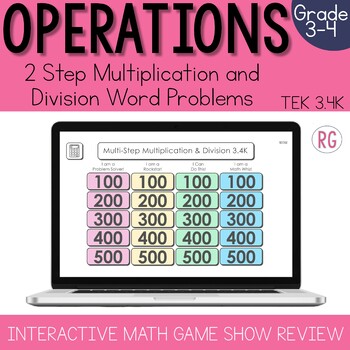2 Step Multiplication and Division Word Problem Game Show | Math Test Review
- PPTX
What educators are saying
Also included in
- This multiplication and division interactive math review game show is a fun way to practice arrays, representing, 2-digit by 1-digit, division as sharing, odd & even, expressions, and so much more!Using this math game show is a fun way to review before the test and help your students understandPrice $30.00Original Price $42.00Save $12.00
Description
This 2 step multiplication and division interactive math review game is a fun way to practice two step word problems. This resource includes a variety of two step multiplication and division word problems. Using this math game show is a fun way to review before the test.
This resource has GREAT test prep questions!
You can use the questions in a Station, Whole Group, Tutoring group, or during intervention time!
TEKS Covered:
3.4K
Common Core Standards covered:
3.OA.A.2
3.OA.A.3
3.OA.A.7
3.OA.A. 8
ALL QUESTIONS ARE RIGOROUS TEST PREP QUESTIONS
If you are looking for worksheets, task cards, board game, or exit tickets for comparing and ordering numbers, then head here instead. The questions in this game show and the printable worksheets are the same.
Other Resources you May Need:
Mixed Operations Input Output Tables BOOM Cards™
Solving Multiplication and Division Word Problems
Describe Multiplication Expressions as Comparisons
Determining Missing Factors in Multiplication Equations and Division Equations
Multiplication and Division Input Output Tables
Division as Sharing with Equal Groups
2 Digit by 1 Digit Multiplication Word Problems
2 Step Multiplication and Division Word Problems
Finding Quotients using Multiplication and Division Facts
Odd and Even Relationship with Divisibility Rules
Multiplication Strategies Activities
Multiplication and Division Word Problems Strip Diagrams
Have You checked out my Numberless Word Problems?
2nd Grade
Or bundle to save:






